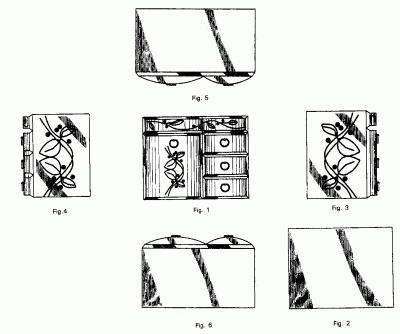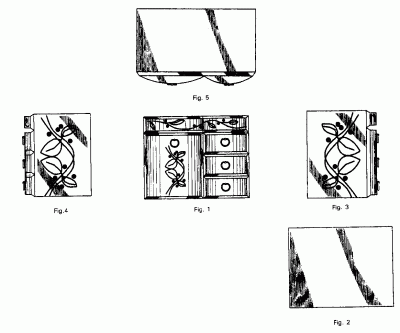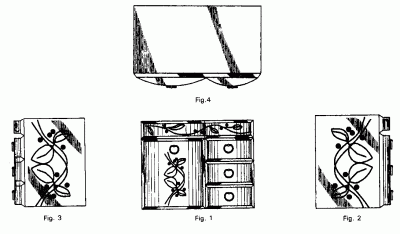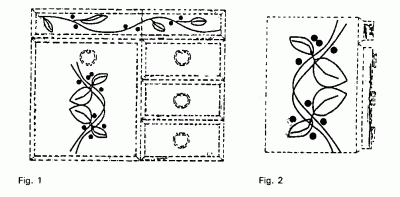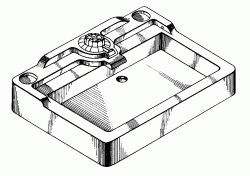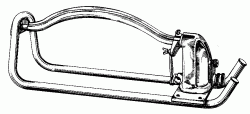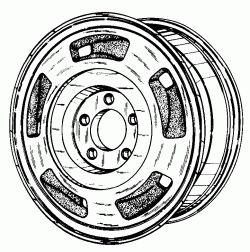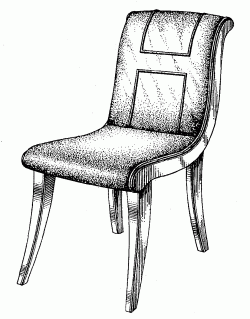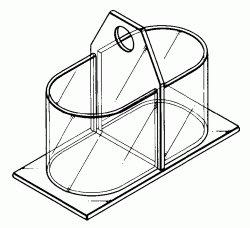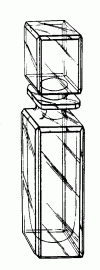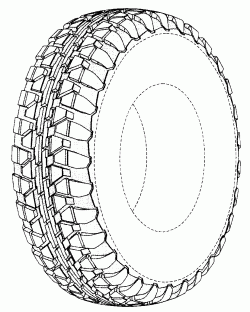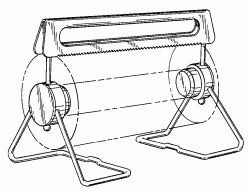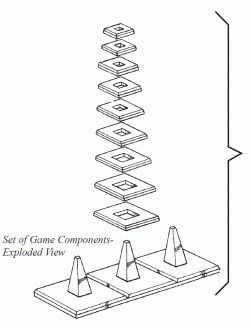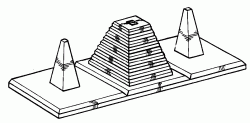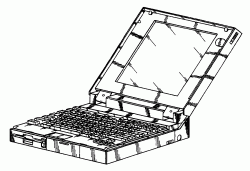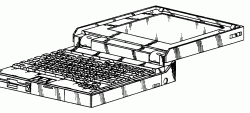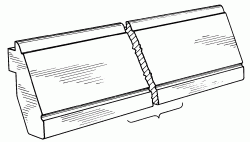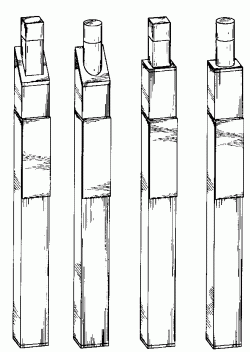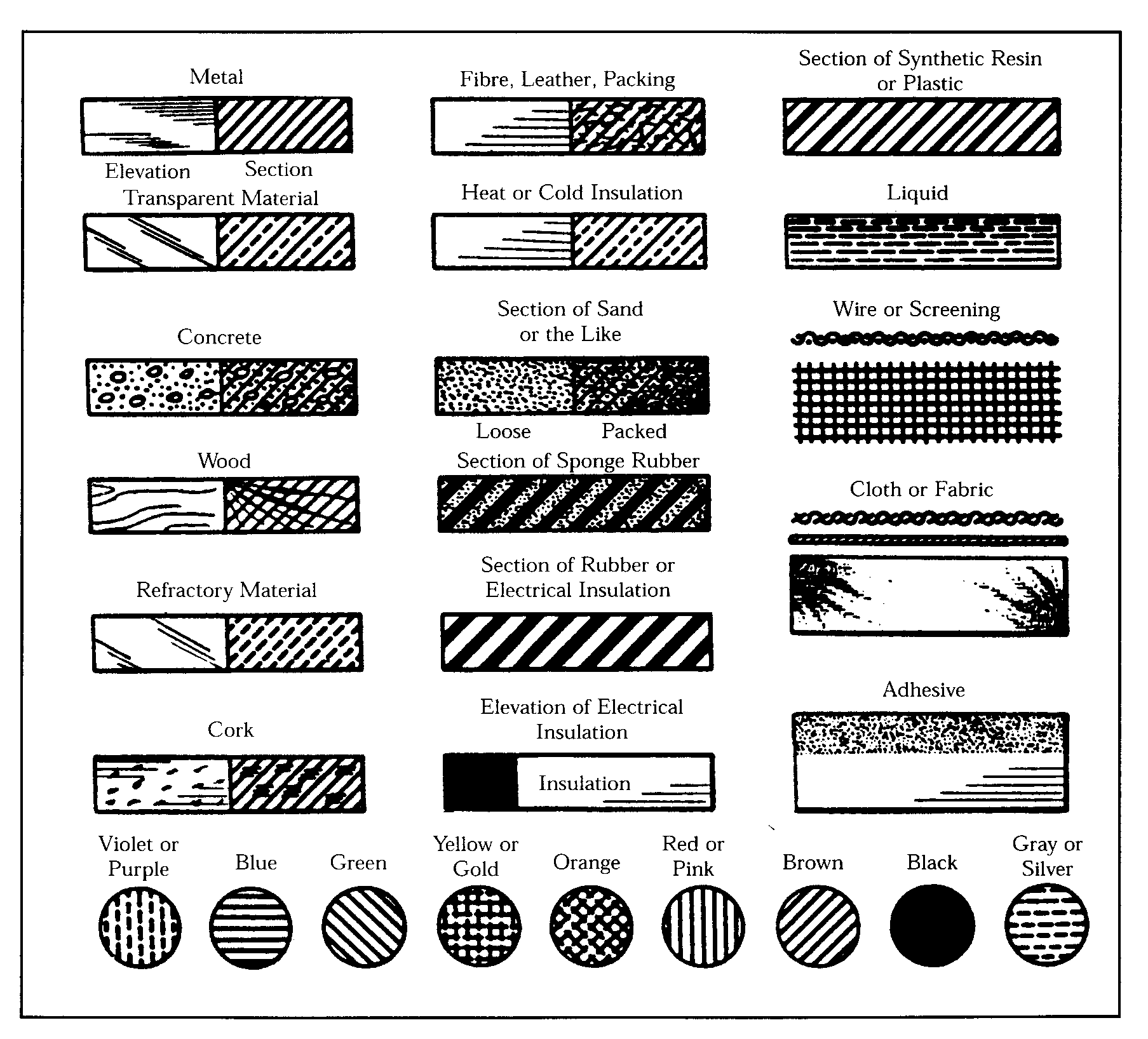Use this in-depth guide to learn the steps and prepare to file a design patent application.
On this page:
- Definition of a design
- Types of design and modified forms
- Invention development organization
- Protecting designs outside the United States
- Elements of a design patent application
- Disclosure examples
- The design patent application process
- Drawing examples
- Drawing symbols
- References and contact information
Definition of a design
A design consists of the visual ornamental characteristics embodied in, or applied to, an article of manufacture. Since a design is manifested in appearance, the subject matter of a design patent application may relate to the configuration or shape of an article, to the surface ornamentation applied to an article, or to the combination of configuration and surface ornamentation.
When the article’s design is only surface ornamentation, the design is inseparable from the article to which it is applied and cannot exist alone. The surface ornamentation must be shown applied to an article of manufacture.
In discharging its patent-related duties, the United States Patent and Trademark Office (USPTO or Office) examines applications and grants patents on inventions when applicants are entitled to them. The patent law provides for the granting of design patents to whomever invents any new, original and ornamental design for an article of manufacture.
The laws and rules governing and pertaining to design patents are linked throughout this guide. You can find to the complete list of the statutes from the United States Code (U.S.C.) and regulations from the Code of Federal Regulations (CFR) that govern design patents and their applications at the bottom of this guide.
The practice and procedures relating to design applications are set forth in chapter 1500 of the Manual of Patent Examining Procedure (MPEP)
Types of designs and modified forms
An ornamental design may be embodied in an entire article (e.g., a vase) or only a portion of an article (e.g., the handle of a cup), or may be ornamentation applied to an article. If a design is directed to just surface ornamentation, it must be shown applied to an article in the drawings. The article must be graphically distinguished from the surface ornamentation (e.g., by showing the article in broken lines). In addition, if broken lines are used for this purpose, a statement must be added to the specification explaining that the broken lines showing the article form no part of the claimed design. A similar statement would be required if a different technique were used to graphically distinguish the article from the surface ornamentation.
A design patent application must only include a single claim (37 CFR § 1.153). Designs that are independent and distinct must be filed in separate applications since they cannot be supported by a single claim. Designs are independent if there is no apparent relationship between two or more articles. For example, a pair of eyeglasses and a door handle are independent articles and their designs must be claimed in separate applications. Designs are considered distinct if they have different shapes and appearances even though they are related articles. For example, the designs for two vases having different surface ornamentation creating distinct appearances must be claimed in separate applications. However, modified forms, or embodiments of a single design concept may be filed in one application when they are not patentably distinct. For example, vases with only minimal configuration differences may be considered a single design concept and both embodiments may be included in a single application MPEP 1504.05
The difference between design and utility patents
In general terms, a “utility patent” protects the way an article is used and works (35 U.S.C. 101), while a "design patent" protects the way an article looks (35 U.S.C. 171). Both design and utility patents may be obtained on an article if invention resides both in its utility and ornamental appearance. While utility and design patents afford legally separate protection, articles of manufacture may possess both functional and ornamental characteristics (MPEP 1502.01).
Improper subject matter for design patents
A claim to a picture, print, impression, etc. per se, that is not applied to or embodied in an article of manufacture is not proper statutory subject matter under 35 U.S.C. 171 (MPEP 1504.01). Also, a design for an article of manufacture that is dictated primarily by the function of the article lacks ornamentality and is not proper statutory subject matter under 35 U.S.C. 171. Specifically, if the appearance of the design is purely dictated by function (i.e., no alternative designs could have served the same function), then the design lacks ornamentality and is not proper subject matter for a design patent (MPEP 1504.01(c)). In addition, 35 U.S.C. 171 requires that a design to be patentable must be “original.” A design that simulates a well-known or naturally occurring object or person is not original as required by the statute (MPEP 1504.01(d)). Furthermore, subject matter that could be considered offensive to any race, religion, sex, ethnic group, or nationality is not proper subject matter for a design patent application (MPEP 608 and 37 CFR § 1.3).
Invention development organizations
Invention development organizations (IDO) are private and public consulting and marketing businesses that exist to help inventors bring their inventions to market, or to otherwise profit from their ideas. While many of these organizations are legitimate, some are not. Be wary of any IDO that is willing to promote your invention or product without making a detailed inquiry into the merits of your idea and giving you a full range of options which may or may not include the pursuit of patent protection. Some IDOs will automatically recommend that you pursue patent protection for your idea with little regard for the value of any patent that may ultimately issue. For example, an IDO may recommend that you add ornamentation to your product in order to render it eligible for a design patent, but not really explain to you the purpose or effect of such a change. Because design patents protect only the appearance of an article of manufacture, it is possible that minimal differences between similar designs can render each patentable. Therefore, even though you may ultimately receive a design patent for your IDO-modified product, the protection afforded by such a patent may be somewhat limited. Finally, you should also be aware of the broad distinction between utility and design patents, and realize that a design patent may not give you the protection desired.
Visit our page on scam prevention for more information. See also “The difference between design and utility patents” section above.
Protecting designs outside the United States
The rights granted by a U.S. design patent extend only within the United States and have no effect in foreign countries. Persons wishing to protect their designs in another country must apply for design protection in a specific country or regional intellectual property office. Such persons may wish to consider the filing of an international design application under the Hague Agreement Concerning the International Registration of Industrial Designs (“Hague Agreement”). An international design application has the same effect as a regularly filed application for the grant of design protection in each designated Hague Agreement member country or intergovernmental organization. See also MPEP 2900.
Please note that for inventions made in the United States, the Director of the USPTO must issue a foreign filing license before an inventor can apply for design protection in a foreign country or regional intellectual property office. The filing of a U.S. patent application serves as a request for a foreign filing license. The application’s filing receipt contains further information and guidance as to the status of applicant’s license for foreign filing. See MPEP 140 for more information on obtaining a foreign filing license.
In addition, since the laws concerning the protection of designs differ among countries, persons interested in obtaining design protection abroad are advised to seek guidance from specific foreign countries to ensure that design rights are not lost.
Elements of a design patent application
The elements of a design patent application should include the following (as set forth in 37 CFR 1.154):
- Design application transmittal form (see USPTO form PTO/AIA/18)
- Fee transmittal form (see USPTO form PTO/SB/17)
- Application data sheet (see 37 CFR § 1.76 and USPTO form PTO/AIA/14)
- Specification
- Drawings or photographs
- The inventor's oath or declaration (see 37 CFR § 1.153(b) and USPTO form PTO/AIA/01 or PTO/AIA/08)
Look up USPTO patent application forms.
The specification should include the following sections, where applicable, in order (a section heading in uppercase letters without underlining or bold type should precede the text of the specification sections):
- Preamble, stating the name of the applicant, title of the design, and a brief description of the nature and intended use of the article in which the design is embodied
- Cross-reference to related applications (unless included in the application data sheet)
- Statement regarding federally sponsored research or development
- Description of the figure or figures of the drawing
- Feature description
- A single claim
Sample specifications are included below in the disclosure examples.
Fees
For design applications, a filing fee, search fee, and examination fee are required. View the current Patent Fee Schedule. If an applicant qualifies as a small entity (37 CFR § 1.27) or a micro entity (37 CFR § 1.29), such as a qualifying independent inventor), these fees are reduced. Small entity status may be established by the submission of a simple written assertion of entitlement to small entity status (MPEP 509.03). A signed “CERTIFICATION OF MICRO ENTITY STATUS” is required before any fee can be paid at the micro entity discount. See USPTO forms PTO/SB/15A and PTO/SB/15B.
Preamble
The preamble, if included, should state the name of the applicant, the title of the design, and a brief description of the nature and intended use of the article in which the design is embodied. The preamble introduces the application subject matter and is located at the beginning of the specification. Samples are shown below.
Title
The title of the design must identify the article in which the design is embodied by the name generally known and used by the public. Marketing designations are improper as titles and should not be used. A title descriptive of the actual article aids the examiner in developing a complete field of search of the prior art. It further aids in the proper assignment of new applications (to the appropriate class, subclass, and patent examiner), and the proper classification of the patent upon allowance of the application. It also helps the public in understanding the nature and use of the article embodying the design after the patent has been published. Thus, applicants are encouraged to provide a specific and descriptive title. See MPEP 1503.01 for additional guidance regarding titles.
Figure descriptions
The figure descriptions indicate what each view of the drawings represents, i.e., front elevation, top plan, perspective view, etc.
Any description of the design in the specification, other than the figure descriptions (i.e., description of the figure(s) of the drawing), is generally not necessary since, as a general rule, the drawing is the design's best description. However, a descriptive statement can be included when useful for understanding aspects of the drawing needing explanation.
The following types of descriptive statements are permissible in the specification:
- A description of the appearance of portions of the claimed design which are not illustrated in the drawing disclosure (i.e., “the right side elevational view is a mirror image of the left side”).
- Description indicating that portions of the article that are not shown form no part of the claimed design.
- Statement indicating the purpose of broken lines in the drawing, for example, a statement explaining that environmental structure or boundaries form no part of the design to be patented.
- Description denoting the nature and intended use of the claimed design, if not included in the preamble.
A single claim
A design patent application may only include a single claim. The claim language identifies the subject of the claim as the "ornamental design." It also indicates the article of manufacture to which the design is applied and incorporates the drawings. The claim must be in formal terms to “The ornamental design for (the article which embodies the design or to which it is applied) as shown.” The designation of the article in the claim should be the same as the designation of the article in the title of the invention.
When a descriptive statement is properly included in the specification, the words “and described” should be added to the claim following the term “shown.” The claim should then read “The ornamental design for (the article which embodies the design or to which it is applied) as shown and described.” See MPEP 1503.01(III) for more information.
Drawings or photographs
The drawing disclosure is the most important element of the application. Every design patent application must include either a drawing or a photograph of the claimed design. As the drawing or photograph constitutes the entire visual disclosure of the claim, it is of utmost importance that the drawing or photograph be clear and complete, and that nothing regarding the design sought to be patented is left to conjecture. The design drawing or photograph must comply with the disclosure requirements of 35 U.S.C. 112, first paragraph. To meet the requirements of 35 U.S.C. 112, the drawings or photographs must include a sufficient number of views to constitute a complete disclosure of the appearance of the design claimed.
Photographs and ink drawings may be included in the same application; however, photographs and ink drawings must not be used to disclose the same embodiment of the claimed design. The use of both photographs and ink drawings in the same embodiment would result in a high probability of inconsistencies between corresponding elements on the ink drawings as compared with the photographs. Photographs submitted in lieu of ink drawings are limited to showing the article to which the design is applied and must exclude the article’s environment.
Black-and-white drawings or photographs
Drawings are normally required to be in black ink on white paper. Black and white photographs, in lieu of drawings, are permitted subject to the requirements of 37 CFR § 1.84(b)(1) and § 1.152. Applicant should refer to these rules, included at the end of this guide. These rules set forth in detail the requirements for proper drawings in a design patent application.
Black and white photographs submitted on double weight photographic paper must have the drawing figure number entered on the face of the photograph. Photographs mounted on Bristol board may have the figure number shown in black ink on the Bristol board, proximate the corresponding photograph. Black and white line drawings and photographs may be submitted electronically via the USPTO patent electronic filing system. Read our Legal information and guidance webpage for information regarding the legal framework that supports the USPTO’s patent electronic filing system and MPEP 502.05.
Color drawings or color photographs
Color drawings are permitted in design applications when filed in accordance with the requirements of 37 CFR § 1.84(a)(2). Color photographs are permitted in design applications when filed in accordance with the requirements of 37 CFR § 1.84(b)(2). Where a design application contains color drawings/photographs, the application must include one (1) set of color drawings/photographs if submitted via the USPTO patent electronic filing system or three (3) sets of color drawings/photographs if not submitted via the USPTO patent electronic filing system and the specification must contain the following language before the description of the drawings:
The patent or application file contains a least one drawing/photograph executed in color. Copies of this patent or patent application publication with color drawing(s)/photograph(s) will be provided by the Office upon request and payment of the necessary fee.
If color photographs or color drawings are filed with the original application, color will be considered an integral part of the disclosed and claimed design. The omission of color in later filed photographs or drawings will be permitted if it is clear from the application that applicant had possession of the underlying configuration of the basic design without the color at the time of filing of the application.
If color photographs or color drawings are submitted and the applicant does not consider the color to be part of the claimed design, a descriptive statement should be included as part of the original specification as follows: “The color shown on the claimed design forms no part thereof.” Petitions for color drawings and color photographs are no longer required for design applications.
Example of a color photograph disclosure:
The views
The drawings or photographs should contain a sufficient number of views to completely disclose the appearance of the claimed design, i.e., front, rear, right and left sides, top and bottom. Perspective views are suggested as they can be helpful in showing the appearance of three dimensional designs. Drawings or photographs that contain a combination of plan, elevation and perspective views may help assure the drawings meet the disclosure requirements of the Office.
If the left and right sides of a design are identical or are a mirror image of one another, a view may be provided of one side and a statement made in the drawing description that the other side is identical or the other side is a mirror image. If the bottom of the design is flat, a view of the bottom may be omitted if a statement is made in the drawing description that the bottom is flat with no surface ornamentation. In some cases, sides of the article that are not visible during normal use do not need to be shown. A sectional view that helps to understand the external appearance of the design is permissible, however a sectional view presented to show strictly the interior structure of the article is neither required nor permitted. See MPEP 1503.02(I) for more information.
Surface shading
While surface shading is not required under 37 CFR § 1.152, it may be necessary in particular cases to include surface shading to show the character and contour of the article’s surfaces that are included in the claimed design. Surface shading is also necessary to distinguish between any open and solid areas of the design. Solid black surface shading is not permitted except when used to represent the color black or used to represent color contrast. Lack of appropriate surface shading in the drawing as filed may render the design, for example, nonenabling and indefinite under 35 U.S.C. 112(a) and (b). Additionally, if the shape of the design is not evident from the disclosure as filed, adding surface shading after filing may be viewed as new matter. New matter is subject matter added after the original filing date which finds no support in the disclosure of the application as filed (see MPEP 608.04, and see 35 U.S.C. 132 and 37 CFR § 1.121(f)). See also MPEP 1503.02(II) for more information.
Broken lines
Anything shown in the drawing that is not considered to be a part of the claimed design may be distinguished from the claimed design by showing it in broken lines. The two most common uses of broken lines are to disclose the environment related to the claimed design and to define the bounds of the claim. Occasionally broken lines may be necessary to show features included in a claimed design such as stitching on a garment.
Structure that is not part of the claimed design, but is considered necessary to show the environment in which the design is used, may be represented in the drawing by broken lines. This includes any portion of an article in which the design is embodied, or to which the design is applied, that is not considered part of the claimed design. When the claim is directed only to surface ornamentation for an article, the article to which the surface ornamentation is applied must be shown in broken lines.
In general, when broken lines are used, they should not interfere with a clear understanding of the claimed design and should not be of heavier weight than the lines used in depicting the claimed design. Where a broken line showing of environmental structure must necessarily cross or intrude upon the representation of the claimed design and obscures a clear understanding of the design, such an illustration should be included as a separate figure in addition to the other figures which show the subject matter of the design unobscured.
Broken lines may not be used to show hidden planes and surfaces which cannot be seen through opaque materials. When broken lines are used, especially those which cross over the full line showing of the design, it is critical that the description of the broken lines in the specification explicitly identifies their purpose so that the scope of the claim is clear. See MPEP 1503.02(III) for more information.
Oath or declaration
An oath or declaration is a formal statement that must be made by the inventor in a non-provisional application, including utility, design, plant and reissue applications. Either form PTO/AIA/01 or PTO/AIA/08 may be used to make the required declaration in a non-provisional application. It is preferred that applicants use form PTO/AIA/01, which must be filed together with an application data sheet (form PTO/AIA/14). Each inventor must sign an oath or declaration that includes certain statements required by law and the USPTO rules, including the statement that he or she believes himself or herself to be the original inventor or an original joint inventor of a claimed invention in the application, and the statement that the application was made or authorized to be made by him or her. See 35 U.S.C 115 and 37 CFR § 1.63. An oath must be sworn to by the inventor before a notary public. A declaration may be submitted in lieu of an oath. A declaration does not need to be notarized. Oaths or declarations are required for design, plant, utility, and reissue applications. In addition to the required statements, the oath or declaration must set forth the legal name of the inventor and, if not provided in an application data sheet, the inventor's mailing address and residence. In lieu of an oath or declaration, a substitute statement may be signed by the applicant with respect to an inventor who is deceased, legally incapacitated, cannot be found or reached after diligent effort, or has refused to execute the oath or declaration. Joint inventors who are the applicant may sign a substitute statement for an inventor who cannot be found or reached after diligent effort or has refused to execute the oath or declaration. However, joint inventors cannot sign a substitute statement for an inventor who is deceased or legally incapacitated. A legal representative of the deceased or legally incapacitated inventor or the assignee who is the applicant may sign a substitute statement for a deceased or legally incapacitated inventor. The assignee (or party to whom the inventor is obligated to assign the invention) who is the applicant may sign a substitute statement for an inventor who is deceased, legally incapacitated, cannot be found or reached after diligent effort, or has refused to execute the oath or declaration. Form PTO/AIA/02 is the USPTO's substitute statement form for filing utility applications in these situations. When filing a continuing application, a copy of the oath or declaration filed in the earlier application may be used provided that it complies with the rules in effect for the continuing application (i.e., the rules that apply to applications filed on or after September 16, 2012). The oath or declaration must be personally signed by the inventor, either with a handwritten signature (i.e., pen applied to paper) or an "S-signature" (a typed name or electronic image of a handwritten signature inserted between forward slashes on the signature line). Each inventor's legal name is required.
Any oath or declaration must be in a language the inventor understands. If the oath or declaration used is in a language other than English and is not in a form provided by the USPTO or provided in accordance with Patent Cooperation Treaty (PCT) Rule 4.17(iv), an English translation together with a statement that the translation is accurate is required. The USPTO currently provides translations of forms PTO/AIA/01 and PTO/AIA/02 into 10 languages: Chinese (simplified), Dutch, French, German, Italian, Japanese, Korean, Russian, Swedish, and Spanish. The oath or declaration required of the inventor must comply with the requirements set forth in 37 CFR § 1.63 and 37 CFR § 1.69.
Disclosure examples
So that the applicant will better understand what constitutes a complete disclosure, examples of drawing disclosures and their accompanying specifications are provided on the following pages.
Example 1 - Disclosure of the entire article
Disclosure of the entire article
I, John Doe, have invented a new design for a jewelry cabinet, as set forth in the following specification. The claimed jewelry cabinet is used to store jewelry and could sit on a bureau.
Fig. 1 is a front elevational view of a jewelry cabinet showing my new design;
Fig. 2 is a rear elevational view thereof;
Fig. 3 is a left side elevational view thereof;
Fig. 4 is a right side elevational view thereof;
Fig. 5 is a top plan view thereof; and
Fig. 6 is a bottom plan view thereof.
I claim: the ornamental design for a jewelry cabinet as shown.
Example 2 - No bottom view or description necessary
Disclosure of only the surfaces of an article that are visible during use (no bottom view or description necessary)
I, John Doe, have invented a new design for a jewelry cabinet, as set forth in the following specification. The claimed jewelry cabinet is used for storing jewelry and could sit on a bureau.
Fig. 1 is a front elevational view of a jewelry cabinet showing my new design;
Fig. 2 is a rear elevational view thereof;
Fig. 3 is a left side elevational view thereof;
Fig. 4 is a right side elevational view thereof;
Fig. 5 is a top plan view thereof.
I claim: the ornamental design for a jewelry cabinet as shown.
Example 3 - Rear view disclosed by description
Disclosure of only the surfaces of an article that are visible during use - The rear view disclosed by description
I, John Doe, have invented a new design for a jewelry cabinet, as set forth in the following specification. The claimed jewelry cabinet is used for storing jewelry and could sit on a bureau.
Fig. 1 is a front elevational view of a jewelry cabinet showing my new design;
Fig. 2 is a left side elevational view thereof;
Fig. 3 is a right side elevational view thereof; and
Fig. 4 is a top plan view thereof.
The rear of the jewelry cabinet is flat and unornamented.
I claim: the ornamental design for a jewelry cabinet as shown and described.
Example 4 - Disclosure of surface pattern applied to an article
Disclosure of a surface pattern applied to an article
I, John Doe, have invented a new design for a jewelry cabinet with surface pattern applied, as set forth in the following specification.
Fig. 1 is a front elevational view of a jewelry cabinet with surface pattern;
Fig. 2 is a left side elevational view thereof, the right side being a mirror image.
The broken lines showing a jewelry cabinet forms no part of the claimed design.
I claim: the ornamental design for a jewelry cabinet with surface pattern as shown and described.
The design patent application process
Preparing a successful design patent application and interacting with the USPTO until a patent is issued (i.e., prosecuting the design patent application) requires knowing patent laws and rules along with knowledge of USPTO practices and procedures. Even though the Office recommends engaging a registered patent attorney or patent agent to file and prosecute applications, a knowledgeable applicant may successfully prosecute his or her own application. For more information read about our Pro Se Assistance Program.
The drawing disclosure is a critical part of a design patent application because it depicts the claimed design. It is essential that the applicant present a set of drawings (or photographs) of the highest quality which conform to the rules and policies pertaining to the drawing disclosure of a design patent application. Changes to these drawings after the application has been filed that introduce new matter are not permitted (35 U.S.C. 132, 35 U.S.C. 112(a)). It is in applicant's best interest to ensure that the drawing disclosure is clear and complete prior to filing the application, since an incomplete or poorly prepared drawing may result in a fatally defective disclosure which cannot become a patent. It is recommended that applicant retain the services of a professional draftsperson who specializes in preparing design patent drawings. Examples of acceptable drawings and drawing disclosures are included in this guide.
Filing an application
In addition to the drawing disclosure, certain other information is necessary. While no specific format is required for the application papers, it is strongly suggested that applicant follow the formats presented herein to ensure that the application is complete.
A design patent application can be filed with the USPTO through the USPTO's patent electronic filing system, by mail via the U.S. Postal Service, or by hand delivery to the Office in Alexandria, Virginia. The USPTO patent electronic filing system is a web-based patent application and document submission system with which anyone using a web-enabled computer may file patent applications and documents without downloading special software or changing document preparation tools and processes. Full technical support for the USPTO patent electronic filing system is available through the Patent Electronic Business Center (EBC) at 866-217-9197 from 6 a.m. to midnight ET, Monday through Friday, except Federal holidays. You'll find more information about the USPTO patent electronic filing system, on our Patent Electronic Business Center webpage.
When a design patent application that includes at least a specification, a drawing and a claim is received by the Office, it is assigned an Application Number and a Filing Date. A "Filing Receipt" containing this information is sent to the applicant. Applicant should promptly review the Filing Receipt to ensure that information on the Filing Receipt is accurate, for example, that all inventor names are spelled correctly and any benefit or priority claims have been recognized by the Office. Once the application is in condition for examination, the application is then assigned to an examiner. As a general guideline, applications are examined in order of their filing date.
Examination
The actual “examination” entails, for example, checking the application to ensure that all formal requirements have been met, ensuring the design can be understood from the drawing disclosure, and making a comparison of the claimed subject matter with the “prior art.” “Prior art” consists of issued patents and published materials that are “prior” to the application’s effective filing date. If the claimed subject matter is found to be patentable, the application will be “allowed,” and instructions will be provided to applicant for completing the process to permit issuance as a patent.
The examiner may reject the claim in the application if the disclosure cannot be understood or is incomplete, or if a reference or combination of references found in the prior art, shows the claimed design to be unpatentable. In addition, the examiner may make an objection as to a matter of form (e.g., an objection to the drawing disclosure). The examiner will then issue an Office action detailing any objections and/or rejections and thereby discuss the substantive matters which affect patentability.
This Office action may also contain suggestions by the examiner for amendments to the application. Applicant should keep this Office action for his or her files, and not send it back to the Office.
Response
If, after receiving an Office action, applicant elects to continue prosecution of the application, a timely reply to the action must be submitted. This reply should include a request for reconsideration or further examination of the claim, along with any amendments desired by the applicant, and must be in writing. The reply must distinctly and specifically point out the supposed errors in the Office action and must address every objection and/or rejection in the action. If the examiner has rejected the claim over prior art, a general statement by the applicant that the claim is patentable, without specifically pointing out how the design is patentable over the prior art, does not comply with the rules.
In all cases where the examiner has said that a reply to a requirement is necessary, or where the examiner has indicated patentable subject matter, the reply must comply with the requirements set forth by the examiner, or specifically argue each requirement as to why compliance should not be required.
In any communication with the Office, applicant should include the following items:
- Application number (checked for accuracy).
- Group art unit number (copied from filing receipt or the most recent Office action).
- Filing date.
- Name of the examiner who prepared the most recent Office action.
- Title of invention.
It is applicant's responsibility to make sure that the reply is received by the Office prior to the expiration of the designated time period set for reply. This time period is set to run from the “Date Mailed,” which is indicated on the first page of the Office action. If the reply is not received within the designated time period, the application will be considered abandoned. In the event that applicant is unable to reply within the time period set in the Office action, abandonment may be prevented if a reply is filed within six months from the mail date of the Office action provided a petition for extension of time and the fee set forth in 37 CFR § 1.17(a) are filed. The fee is determined by the amount of time requested, and substantially increases as the length of time increases. An “Extension of Time” does not have to be obtained prior to the submission of a reply to an Office action; it may be mailed along with the reply. For current fees, read through our USPTO fee schedule. Note: an extension of time cannot be obtained when responding to a “Notice of Allowance and Fee(s) Due.” See MPEP 502 for more information on depositing a correspondence.
To ensure that a time period set for reply to an Office action is not missed; a “Certificate of Mailing” should be attached to the reply. This “Certificate” establishes that the reply is being mailed on a given date. It also establishes that the reply is timely, if it was mailed before the period for reply had expired, and if it is mailed with the United States Postal Service. A “Certificate of Mailing” is not the same as “Certified Mail.” See MPEP 512 for more information on Certificate of Mailing.
A suggested format for a Certificate of Mailing is as follows (see also USPTO form PTO/SB/92):
"I hereby certify that this correspondence is being deposited with the United States Postal Service as first class mail in an envelope addressed to: Commissioner for Patents, PO Box 1450, Alexandria, Virginia 22313-1450, on (DATE MAILED)"
(Name - Typed or Printed) __________________________________
Signature__________________________________
Date______________________________________
If a receipt for any paper filed in the USPTO is desired, applicant should include a stamped, self-addressed postcard, which lists, on the message side, applicant's name and address, the application number, and filing date, the types of papers submitted with the reply (e.g., 1 sheet of drawings, 2 pages of amendments, 1 page of an oath/declaration, etc.). This postcard will be stamped with the date of receipt by the mailroom and returned to applicant. This postcard will be applicant's evidence that the reply was received by the Office on that date.
If applicant changes his or her mailing address after filing an application, the Office must be notified in writing of the new address. Failure to do so will result in future communications being mailed to the old address, and there is no guarantee that these communications will be forwarded to applicant's new address. Applicant's failure to receive, and properly reply to these Office communications will result in the application being held abandoned. Notification of “Change of Address” should be made by separate letter, and a separate notification should be filed for each application, e.g., change of correspondence address form PTO/AIA/122 available our Forms for patent applications webpage.
Reconsideration
Upon submission of a reply to an Office action, the application will be reconsidered and further examined in view of applicant's remarks and any amendments included with the reply. The examiner will then either, withdraw the rejection and allow the application or, if not persuaded by the remarks and/or amendments submitted, repeat the rejection and make it final. Applicant may file an appeal with the Patent Trial and Appeal Board after receiving a final rejection or after the claim has been rejected twice. Applicant may also file a new application prior to the abandonment of the original application, claiming benefit of the earlier filing date. This will allow continued prosecution of the claim.
Drawing examples
The two types of shading commonly employed in design patent application drawings are straight-line surface shading and stippling. Individually or in combination, they can effectively represent the character and contour of most surfaces.
Straight-line surface shading
Stippling
Combination of straight-line shading and stippling
Note that both stippling and straight-line surface shading, while permissible on the same object to show surface contrast, should not be used together on the same surface.
Transparent materials
Oblique line shading must be used to show transparent or translucent surfaces (as well as highly polished or reflective surfaces such as a mirror). Note that elements visible behind transparent surfaces should be shown in light, full lines, not broken lines.
Broken-line disclosure
Broken lines may be used to show environment and boundaries that form no part of the claimed design.
Exploded view
An exploded view is only supplementary to a fully assembled view. A bracket must be employed to show the association of elements.
Alternate positions
Article shown broken away
Cross-sectional view
Multiple embodiments
Drawing symbols
Color may also be shown in pen and ink drawings by lining the surfaces of the design for color in accordance with the symbols in MPEP § 608.02. If the drawing in an application is lined for color, the following statement should be inserted in the specification for clarity and to avoid possible confusion that the lining may be surface treatment --The drawing is lined for color.-- However, lining entire surfaces of a design to show color(s) may interfere with a clear showing of the design as required by 35 U.S.C. 112(a) (or for applications filed prior to September 16, 2012, pre-AIA 35 U.S.C. 112, first paragraph), as surface shading cannot be used simultaneously to define the contours of those surfaces.
37 CFR § 1.84(n) indicates that graphic drawing symbols and other labeled representations may be used for conventional elements where appropriate, subject to approval by the Office. Also, suitable legends may be used, or may be required, in proper cases. The American National Standards Institute (ANSI) (www.ansi.org) and the International Organization for Standardization (ISO) (www.iso.org) are organizations whose numerous publications include some that pertain to graphical symbols; the symbols therein are considered to be generally acceptable in patent drawings. Although ANSI and ISO documents and other published sources may be used as guides during the selection of graphic symbols for patent drawings, the Office will not "approve" any published collection of symbols as a group because their use and clarity must be decided on a case-by-case basis. Overly specific symbols should be avoided. Symbols with unclear meanings should be labeled for clarification.
Since design patents protect the appearance of an article, graphic drawing symbols in design patent applications should be used judiciously, as the drawing symbol may interfere with a clear showing of the design. See MPEP 1503.02, subsection V. In addition, because color drawings may now be filed in a design application without the need for a petition, applicants may prefer to represent color using color drawings instead of using graphic symbols. See MPEP 1503.02, subsection V, and MPEP 608.02, subsection VIII, for the submission of color drawings in design applications.
The following symbols should be used to indicate various materials where the material is an important feature of the invention. The use of conventional features is very helpful in making prior art searches.
References
Laws that apply to design patent applications
- Conditions for patentability; novelty (35 U.S.C. 102)
- Conditions for patentability; non-obvious subject matter (35 U.S.C. 103)
- Specification (35 U.S.C. 112)
- Note: paragraphs (c)-(f) do not apply to design patent applications
- Notice of rejection; reexamination (35 U.S.C. 132)
- Patents for designs (35 U.S.C. 171)
- Right of priority (35 U.S.C. 172)
- Term of design patent (35 U.S.C. 173)
Regulations that apply to design patent applications
- Business to be conducted with decorum and courtesy (37 CFR § 1.3)
- Inventor's oath or declaration (37 CFR § 1.63)
- Foreign language oaths and declarations (37 CFR § 1.69)
- Application data sheet (37 CFR § 1.76)
- Standards for drawings (37 CFR § 1.84)
- Manner of making amendments in application (37 CFR § 1.121)
- Design drawings (37 CFR § 1.152)
- Title, description and claim, oath or declaration (37 CFR § 1.153)
- Arrangement of application elements in a design application (37 CFR § 1.154)
Contact us
Questions regarding a design patent application and its forms may be directed to one of the Design Patent Practice Specialists of Technology Center 2900.
Mailing address:
United States Patent and Trademark Office
Commissioner for Patents P.O. Box 1450
Alexandria, VA 22313-1450




